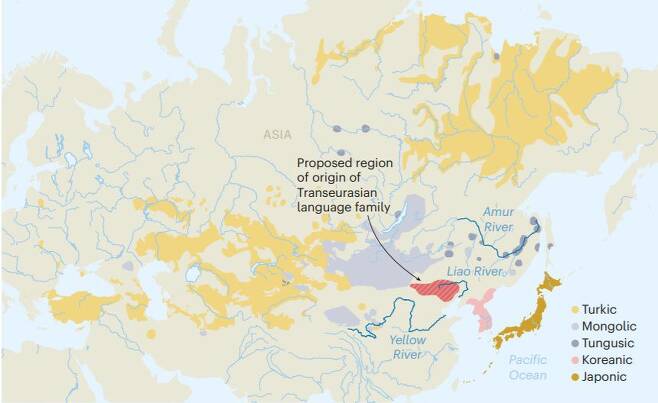- 새로운 뉴스를 올려주세요.
| Date | 21/11/11 09:33:07 |
| Name | 구글 고랭이 |
| File #1 | 2.jpg (27.4 KB), Download : 62 |
| Subject | 한국어 기원은 9000년前 중국 동북부 요하의 농경민 |
|
https://news.v.daum.net/v/20211111070414376 한국어가 투르크어, 몽골어, 일본어와 함께 9000년 전 신석기시대에 중국 동북부에 살던 농경민에서 비롯된 것으로 밝혀졌다. 지금까지는 그보다 훨씬 뒤에 중앙아시아 유목민들이 전 세계로 이주하면서 비슷한 체계를 가진 언어들이 퍼졌다고 알려졌다. 독일 막스플랑크 인류사연구소의 마티너 로비츠 박사 연구진은 “언어학과 고고학, 유전학 연구 결과를 종합 분석한 결과 유럽에서 동아시아에 이르는 트랜스유라시아 어족(語族)이 신석기 시대에 중국 랴오강(遼河,요하) 일대에서 기장 농사를 짓던 농민들의 이주 결과임을 확인했다”고 11일 국제 학술지 ‘네이처’에 밝혔다. 이번 연구에는 독일과 한국·미국·중국·일본·러시아 등 10국 언어학자, 고고학자, 유전생물학자 41명이 참여했으며, 한국외국어대의 이성하 교수와 안규동 박사, 동아대의 김재현 교수, 서울대의 매튜 콘테 연구원 등 국내 연구진도 논문에 공저자로 등재됐다. (..) 이번 ‘농경민 가설’에 따르면 트랜스유라시아 조상 언어는 북쪽과 서쪽으로는 시베리아와 중앙아시아 초원지대로 확산됐고, 동쪽으로는 한국과 일본에까지 이르렀다. 이는 3000~4000년 전 동부 초원지대에서 발원한 유목민이 이주하면서 트랜스유라시아어가 퍼졌다는 ‘유목민 가설’을 뒤집는 결과이다. Triangulation supports agricultural spread of the Transeurasian languages https://www.nature.com/articles/s41586-021-04108-8 The origin and early dispersal of speakers of Transeurasian languages—that is, Japanese, Korean, Tungusic, Mongolic and Turkic—is among the most disputed issues of Eurasian population history. A key problem is the relationship between linguistic dispersals, agricultural expansions and population movements. Here we address this question by ‘triangulating’ genetics, archaeology and linguistics in a unified perspective. We report wide-ranging datasets from these disciplines, including a comprehensive Transeurasian agropastoral and basic vocabulary; an archaeological database of 255 Neolithic–Bronze Age sites from Northeast Asia; and a collection of ancient genomes from Korea, the Ryukyu islands and early cereal farmers in Japan, complementing previously published genomes from East Asia. Challenging the traditional ‘pastoralist hypothesis’, we show that the common ancestry and primary dispersals of Transeurasian languages can be traced back to the first farmers moving across Northeast Asia from the Early Neolithic onwards, but that this shared heritage has been masked by extensive cultural interaction since the Bronze Age. As well as marking considerable progress in the three individual disciplines, by combining their converging evidence we show that the early spread of Transeurasian speakers was driven by agriculture. 트랜스유라시아어족은 알타이 어족이라고도 하는데, 이는 기원과 확산 과정이 불명확해 학계에서 논쟁의 대상이 되었습니다. 이번 연구에서 연구진은 - 한국어는 9000년 전 신석기시대에 중국 동북부 요하 지역에 살다가 이주한 농경민으로부터 비롯됨 - 트랜스유라시아어족은 북쪽과 서쪽으로는 시베리아와 중앙아시아 초원지대로 확산되었고, 동쪽으로는 한국과 일본에까지 이르렀다. - 트랜스유라시아어의 확산은 유목민의 이주가 아닌 농경민의 이동에 따른 결과이다. - 중기 신석기시대 한국인 조상의 유전자는 일본 토착민인 조몬인과 95% 일치한다. 라는 것을 밝혔습니다. 0
이 게시판에 등록된 구글 고랭이님의 최근 게시물
|
|







